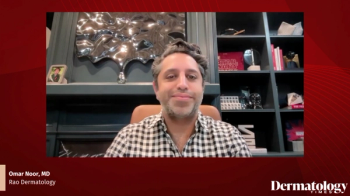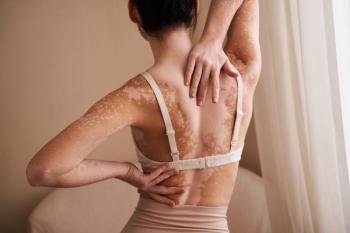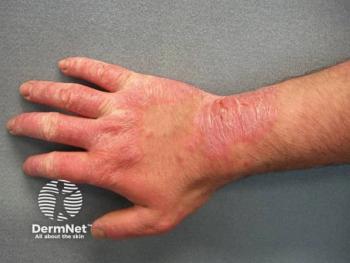
FDA Approves Dupilumab, First and Only Targeted Medicine for Bullous Pemphigoid
Key Takeaways
- Dupilumab is the first FDA-approved targeted therapy for bullous pemphigoid, showing significant efficacy in the LIBERTY-BP ADEPT study.
- The study demonstrated improved disease remission, itch reduction, and reduced corticosteroid use in dupilumab-treated patients compared to placebo.
Dupilumab gains FDA approval as the first targeted therapy for bullous pemphigoid, offering hope for effective treatment and improved patient outcomes.
The
"Dupilumab's approval for the bullous pemphigoid indication is a huge step forward for the immunobullous field,"said Christopher Bunick, MD, PhD, associate professor of dermatology at Yale School of Medicine in New Haven, Connecticut, and editor in chief of Dermatology Times, in a statement. "BP patients have long had to utilize systemic and topical steroids, long-term antibiotics, and other traditional immunosuppressants, with moderate degrees of efficacy and questionable safety risks. Dupilumab represents a major advance in the care of the BP patient, especially elderly patients whose long-term use of the previous therapies carries potential health risks. Dupilumab will change the lives of many BP patients, and I share the excitement with my dermatology colleagues that we now have an effective, safe, on-label immunotherapy for BP."
Clinical Data
The approval is supported by positive data from the pivotal phase 2/3 LIBERTY-BP ADEPT study.2 The randomized, double-blind, placebo-controlled study assessed dupilumab in a cohort of 106 adults with moderate to severe BP over the course of 52 weeks. Patients received dupilumab or placebo plus oral corticosteroids (OCS), which were tapered starting as early as week 4 if disease control was maintained, with a goal of stopping OCS by week 16.
At 36 weeks, 18.3% of dupilumab-treated patients achieved sustained disease remission vs 6.1% with placebo. Clinically meaningful itch reduction was seen in 38.3% vs 10.5%, and median cumulative OCS use was lower (2.8g vs 4.1g).
Common adverse events included arthralgia, conjunctivitis, blurred vision, herpes infections, and keratitis. One dupilumab-treated patient was reported to develop acute generalized exanthematous pustulosis.
Dupilumab also met all secondary endpoints in the ADEPT study with statistically significant results.3 Notably, 41% of patients achieved a ≥90% reduction in disease severity vs 10% on placebo, and 40% reported meaningful itch relief vs 11% on placebo. A greater reduction with dupilumab was observed saw improvements in both disease severity (77% vs 50%) and itch (52% vs 27%), and dupilumab treatment resulted in longer periods of corticosteroid-free remission (40 days vs 13 days).
Additional studies of dupilumab in BP have further demonstrated its efficacy in this indication.
A 2025 comparative study of biologics for BP published in the Journal of Dermatology reported that dupilumab demonstrated superior outcomes to omalizumab (Xolair; Genentech and Novartis Pharmaceuticals Corporation), achieving disease control in 90.6% of patients and complete remission in 87.1%, with lower relapse (10.3%) and discontinuation rates (15.6%).4
Dupilumab also led to faster responses, though differences were not statistically significant. Both drugs were well-tolerated, but dupilumab was especially effective in patients with immunotherapy- or gliptin-associated BP, where all treated individuals achieved disease control without relapse.4
Expert Insights
In the press release, Patrick Dunn, Executive Director of the International Pemphigus and Pemphigoid Foundation, said, “People affected by bullous pemphigoid endure unrelenting itch and painful blisters that can damage the skin. Until now, these primarily elderly patients have had limited therapeutic options available, with potential side effects that have often added to their burden. The approval of Dupixent for bullous pemphigoid brings a novel treatment approach to patients and their caregivers, and we are grateful for the tireless efforts of the scientific community who helped us reach this critical milestone." Representatives from Sanofi and Regeneron also shared their thoughts.
“This approval extends the remarkable ability of Dupixent to transform treatment paradigms for people living with a variety of diseases with underlying type 2 inflammation, from common conditions like asthma and atopic dermatitis, to rarer ones such as eosinophilic esophagitis and prurigo nodularis, and now including bullous pemphigoid," George D. Yancopoulos, MD, PhD, Board co-Chair, President, and Chief Scientific Officer at Regeneron, and a principal inventor of Dupixent, said. "Dupixent has shown the potential to improve the most challenging effects of bullous pemphigoid, while helping some patients achieve sustained disease remission and decreased oral corticosteroid use. Additionally, this approval further reinforces the demonstrated safety profile of Dupixent in a broad age range of patients, from infants to elderly people, and across dermatological, respiratory, and gastrointestinal diseases.”
"Until now, treating bullous pemphigoid was very challenging for elderly patients struggling with the debilitating impact of blisters and lesions, and potentially co-morbid conditions. By addressing two central drivers of the underlying type 2 inflammation that contributes to bullous pemphigoid, Dupixent is the first targeted medicine to allow patients the potential to achieve sustained remission and reduce itch.3 This approval in the US is important for the thousands of patients living with bullous pemphigoid, and we look forward to working with regulators around the world to bring this innovative medicine to more patients in need," said Alyssa Johnsen, MD, PhD, Global Therapeutic Area Head of the Immunology and Oncology Development at Sanofi.
In reflecting on the real-world impact of dupilumab for bullous pemphigoid, Dermatology Times Editorial Advisory Board member Matthew Zirwas, MD, offered a summary that highlights his optimism:
"Way better than the data. If I had to summarize my thoughts on dupilumab in bullous pemphigoid in 5 words or less, I'd use those 5. When we have the first drug for a disease, the patients who get enrolled in the trials are generally 'the worst of the worst.' This was true for dupilumab in atopic dermatitis, and it is true for dupilumab in bullous pemphigoid," Zirwas, a board-certified dermatologist at Bexley Dermatology in Columbus, Ohio, said. "For context, in atopic dermatitis, less than 40% of patients reached the primary endpoint in the dupilumab trials (doesn't sound very impressive), but in real life, only 10% of patients stop dupilumab because of inadequate efficacy. In bullous pemphigoid, I think it will be even more pronounced (for a number of good reasons); while less than 20% of patients hit the primary endpoint in the trials, based on the overall picture, I am betting that dupilumab will be very effective in 90% of patients in our offices."
References
- Press Release: Dupixent approved in the US as the only targeted medicine to treat patients with bullous pemphigoid. News release. Sanofi. June 20, 2025. Accessed June 20, 2025.
https://www.sanofi.com/en/media-room/press-releases/2025/2025-06-20-05-00-00-3102518 - Murrell DF, Joly P, Werth VP, et al. Study design of a phase 2/3 randomized controlled trial of dupilumab in adults with bullous pemphigoid: LIBERTY-BP ADEPT [published correction appears in Adv Ther. 2024 Jul;41(7):3014-3015. doi: 10.1007/s12325-024-02886-x.]. Adv Ther. 2024;41(7):2991-3002.
doi:10.1007/s12325-024-02810-3 - Efficacy and safety of dupilumab in patients with bullous pemphigoid: results From LIBERTY-BP ADEPT Phase 2/3 Study. Late Breaking Research Session 2. Presented at 2025 American Academy of Dermatology Annual Meeting; March 8, 2025; Orlando, Florida.
- Avallone G, Maronese CA, Zussino M, et al. Effectiveness of dupilumab and omalizumab in bullous pemphigoid: A nationwide retrospective cohort study. J Dermatol. Published online April 16, 2025. doi:10.1111/1346-8138.17742
Newsletter
Like what you’re reading? Subscribe to Dermatology Times for weekly updates on therapies, innovations, and real-world practice tips.



















